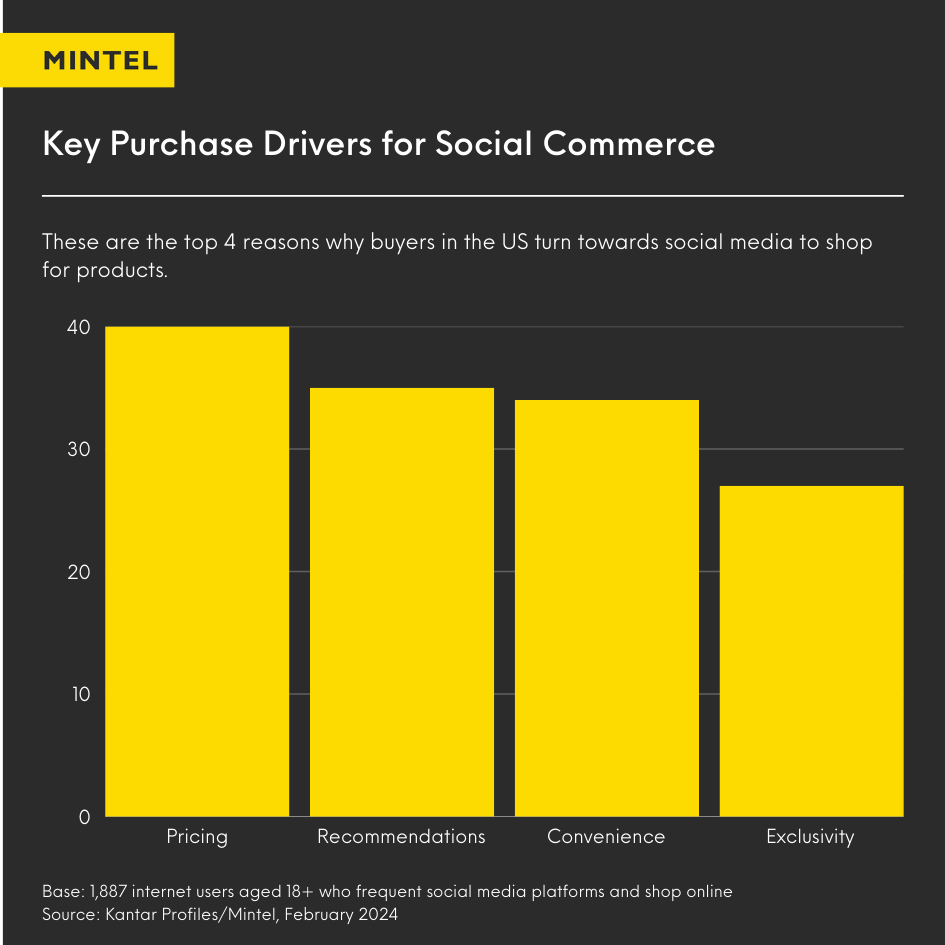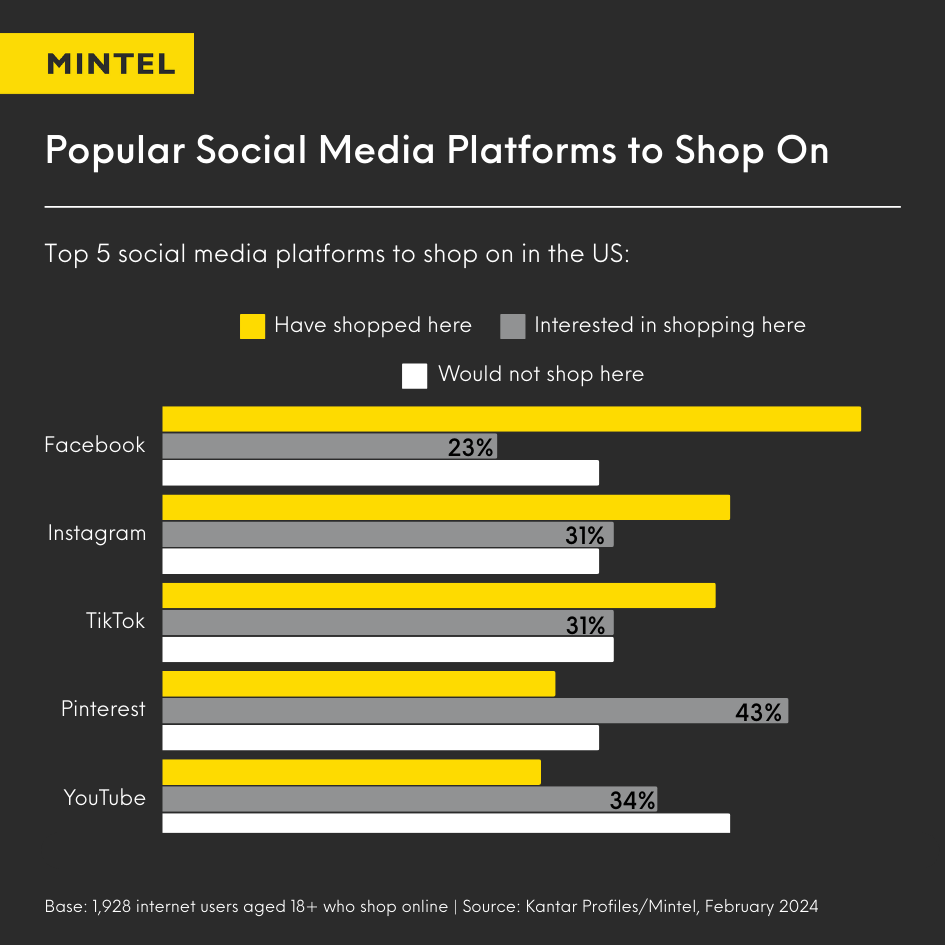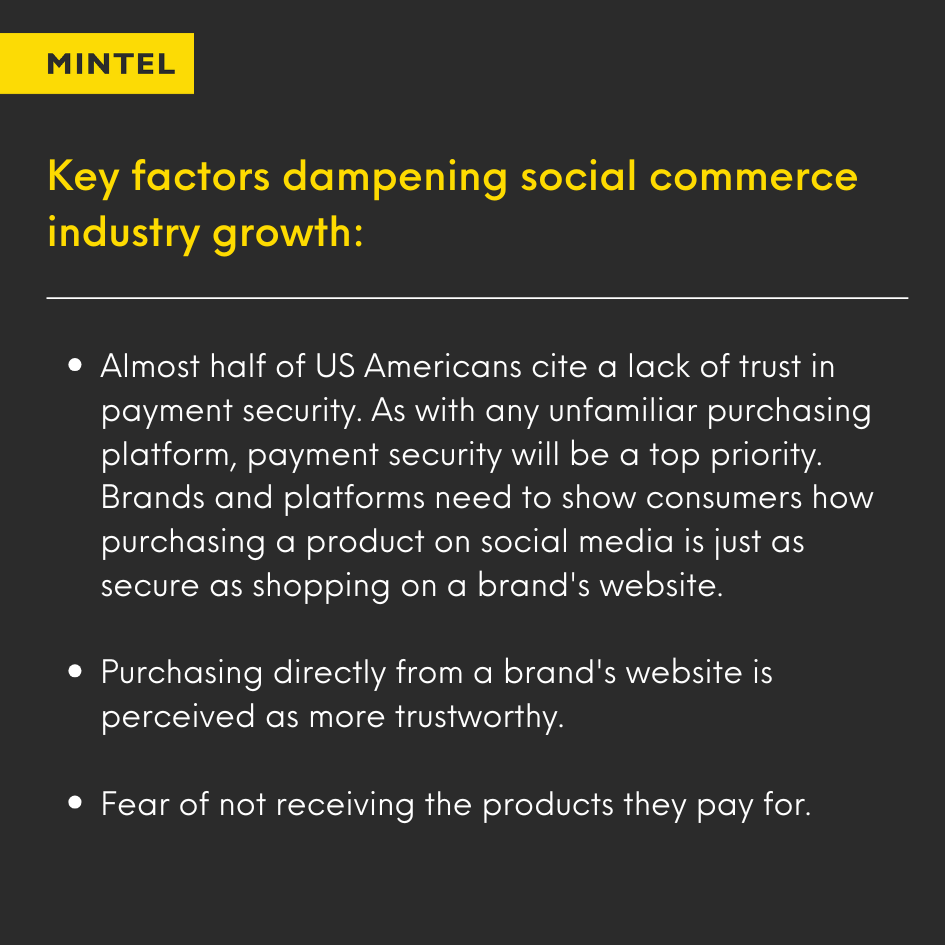Direct-to-consumer shopping, where brands by-pass retailers and sell direct to customers, is becoming increasingly popular.
Given the nature of marketplaces, social commerce is not as straightforward as with mainstream retailers – as it often involves peer-to-peer selling/buying options alongside bigger retailers – but it represents vast opportunities to gain exposure, and might be on the brink of changing how we shop online.
What is social commerce?
Social commerce is the online shopping practice of purchasing items directly on social media platforms where brands advertise their goods. This means that platforms act as an inspiration board, product and brand researching tool, and online shop all in one. Due to the convenience of doing all this in one place, the practice has been on the rise and is quickly turning into a key aspect of the eCommerce ecosystem.
In this article, we’ll dive into the nitty gritty details of the social commerce industry. How can its growing success be explained? What are potential buyers looking for, and how can your business tap into the opportunities social commerce offers?
The Role of Social Media in Consumers’ Purchasing Journey Sets Social Commerce Up for Success
A first touchpoint between brand and buyer
Social media platforms are an increasingly important way for brands and retailers to reach consumers and build awareness. TikTok, in particular, is driving growth in this area by enhancing search functions by including sustainable shopping categories, such as ‘Pre-owned Luxury’ and ‘Refurbished Technology’.
Social media sparks inspiration
The influence of social media on users’ customer journey and purchases is undeniable. Up until recently, consumers have mostly used social media mainly to browse and get inspiration when shopping online, rather than to buy items. Just over half of German fashion shoppers seek inspiration online. Younger generations, particularly those aged 16 to 24, are especially influenced by social media and influencers for clothing and make-up inspiration. With these shifting behaviours in mind, online reviews on social platforms are a powerful tool brands shouldn’t underestimate. Women frequently turn to these and social platforms in general for fashion trends, peer reviews, and influencer endorsements.
How Consumers are Navigating the Growing Social Commerce Market


Source: Mintel’s US Social Commerce Market Report.
Successful social commerce marketing can transform interest into sales
Mintel analysts determine four main purchase drivers in the social commerce industry:


1. Price remains a key tool for a successful social commerce strategy: As economic uncertainty continues, buyers remain cautious in their spending behaviour, making price the main consideration. Competitive pricing strategies and prominently highlighting any discounts or special offers can draw shoppers onto the social commerce market en masse, particularly younger generations.
2. Engaging content can drive interest and ensure trust: Engaging content is a key driver of purchases on social media platforms and can influence participation. Showcasing a product’s use in real-life scenarios and sharing brand/product stories can help build trust and deepen connections with customers. Providing transparent information and further aftersales guarantees may attract potential buyers. Aftersales services are a fast emerging social commerce trend, and an area where social media as a shopping platform may lag behind more traditional retail channels.
3. The convenience and benefits of social commerce platforms can encourage purchases: While most social commerce purchases are planned, consumers are more likely to make spontaneous and on-demand purchasing decisions due to the convenience and immediacy offered by these platforms. However, brands also shouldn’t ignore the desire for human connection even in the digital world. Younger consumers, particularly younger men, want a human to respond on social media’s chat features instead of bots; while a bot might be able to respond immediately, a response from a human might be more pointed and cut down on how many automations a consumer may need to receive to find their answer.
4. Exclusivity can improve the perception of goods offered on the social commerce market: Exclusive offerings, including benefits and product bundles, play into consumers’ buying decisions. The target group of 50 to 59-year-olds are especially attracted by exclusive products and product bundles with 41% of them having expressed interest.
Participation in the social commerce market
60% of TikTok users in the UK have bought a product or service directly from a social media platform.
Compared to 2023, purchase participation via social media has increased slightly in 2024, however, numbers in the US are still lagging behind the UK: Over 40% of US Americans have made a purchase on social media and would do so again, and another 17% who haven’t participated in the social commerce market yet, would be interested in doing so.
Social commerce trends: devices used to shop on social media
While total sales from social media remain relatively small compared to total retail numbers, sales from mobile retailing are expected to encompass about 45% of total US eCommerce sales, showing how important the mobile and social commerce experience is to online shoppers. The growth of the social commerce industry over the next few years is therefore closely linked to mobile use. As people spend more time on their phones, they’ll complete more shopping on their devices, which will further drive the growth of the social commerce market. Vice versa, this means that social commerce will play a key role in the acceleration of sales numbers of mobile devices.
Popular platforms to shop at in the social commerce market


Marketplace has led to huge success in the peer-to-peer selling space, giving Facebook an advantage in purchases already made. However, TikTok and Instagram have the advantage of being able to connect with more consumers across generations and gender. Gen Z is most likely to have shopped on both TikTok and Instagram before; both platforms hold significant opportunities to also effectively engage Millennials and Gen X through shoppable content.
Although Pinterest only comes fourth in the overall ranking of platforms shopped at, it’s the top platform buyers say they would be comfortable shopping on if they haven’t already. Having originally launched as a place where users could express their aspirations and find inspiration for future purchases, Pinterest can elevate its original purpose and aim to convert future desires into purchases. Facebook and Instagram were originally intended for connecting with others and sharing elements of personal lives, which might be why some are more hesitant to dip into the newly emerging social commerce aspect of these platforms.
Barriers to Shopping on Social Media Platforms
Our analysts’ market research shows that social media users are still testing the waters and aren’t ready to dive head-first into social commerce just yet. They are still learning about the process and the options available to them. Therefore, education and support are still highly needed from brands and platforms alike.


Source: Mintel’s US Social Commerce Market Report.
As a lack of overall trust lies at the heart of all of the above-mentioned barriers, it will be paramount for retailers to address issues of trust in their use of personal data, product authenticity, as well as certification.
While TikTok Shop has already launched in the US and other countries, and is gaining traction, the scheduled launch in Germany has been postponed indefinitely, thereby preventing the growth in a significant market: As of September 2023, 43% of Germans who typically go on social media first when looking for ideas and information, would prefer to buy products directly via social media rather than being directed to a retailer’s website. This is due to limited trust in data privacy and online payments.
What makes a Successful Social Commerce Strategy?
Price and value are top of mind
In times where value and pricing is top of mind for shoppers, special pricing strategies can drive interest and is one of the top purchase motivators on social media. Brands can tap into this tactic to encourage potential buyers to immerse themselves in all the possibilities shopping on social media platforms has to offer, as well as entice shoppers to stay engaged with the brand to see future offers and products.
Engaging content is one of social commerce’s strongest appeals
Because social media has become a crucial part during the research phase of the shopping journey, providing helpful information such as product details, consumer reviews, and testimonials is pivotal.
56% of US Americans pay attention to customer reviews posted on social media.
This figure shows how important the recommendations made by people they trust are to buyers – whether they be friends/family members, or social media personalities they frequently engage with. Brands can look to leverage the trust consumers have in others through partnerships with relatable influencers, as well as incorporating referral programs.
While social proof through recommendations and reviews is part of a successful social commerce strategy, empowering consumers’ autonomy with information is also a powerful tool for brands to have, thus supporting them in making decisions themselves rather than having others decide for them. To do so, interactive product and brand storytelling are a key element and can enhance communication.
Easier said than done. Today’s social media users have access to an abundance of content. This presents a challenge for brands vying for attention in the increasingly competitive social commerce market. Providing consumers with an interactive and entertaining shopping experience is an effective way to achieve this and stimulate consumption. In this space, social commerce actually has strong advantages in content delivery compared to more traditional forms of retail, as social platforms can enhance the experience and entertainment aspects of consumption.
- engaging content,
- comprehensive product information,
- and social proof
form a promising social commerce strategy that can enhance the sense of value for buyers.
Livestreaming proves to be an emerging social commerce trend
Livestreaming, where audience members watch their favourite brands/influencers in real time, is emerging as a driving force in social commerce marketing. As of June 2023, the number of livestreaming eCommerce users in China has reached 526 million. Chinese platforms Douyin and Kuaishou lead in livestreaming purchases, indicating strong synergies between livestreaming and short video platforms. Users can effortlessly discover livestreams while browsing video content, without having to navigate to different interfaces. This seamless integration makes livestreaming so effective, as a few seconds of engaging content can capture user interest and potentially lead to sales.
The use of livestreaming can also foster community. Younger users are especially seeking connection. Livestreaming helps connect consumers with others of similar mindsets and interests. Brands and platforms could also look to create dedicated groups on livestream feeds based on certain interests or demographics, for example parents or sustainably conscious shoppers.
Lead the Social Commerce Industry into the Future with Mintel
While younger consumers will drive much of the growth in the social commerce market, consumers across all generations will gain increased familiarity and confidence with the social shopping process, ensuring that social media will continue to be a prime point for engagement and connection with brands regardless of purchase habits.
Looking ahead, livestreaming could revolutionise how other retail formats interact with consumers, as it opens up new avenues for personalisation, user engagement, and content delivery.
Moving forward, platforms will have more options to leverage Gen AI to improve consumers’ interactions with brands, and early adopters of these features are likely to gain interest from Gen Z, Gen Alpha, and Young Millennials.
Even though the scheduled launch of TikTok Shop in Germany has been postponed indefinitely, brands in markets where this and similar platforms aren’t available yet must monitor the progress and development of in-app shopping to not miss out on future opportunities.
If you’re interested in more market insights and fresh perspectives from our analysts, subscribe to our free newsletter Spotlight.
Browse the Mintel Store to explore all our Social Media market research and Retail market research.
